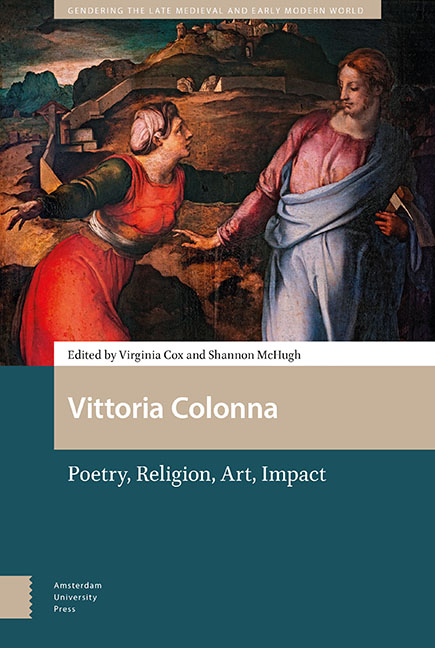Book contents
- Frontmatter
- Dedication
- Contents
- List of Illustrations
- Acknowledgements
- Introduction: The Twenty-First Century Vittoria Colonna
- Part 1 Literary and Spiritual Sociability
- Part 2 Widowhood
- Part 3 Poetry
- Part 4 Art
- Part 5 Readership
- Part 6 Impact
- Volume Bibliography
- Index of Citations of Colonna’s Letters and Verse
- Thematic Index
Introduction: The Twenty-First Century Vittoria Colonna
Published online by Cambridge University Press: 16 December 2021
- Frontmatter
- Dedication
- Contents
- List of Illustrations
- Acknowledgements
- Introduction: The Twenty-First Century Vittoria Colonna
- Part 1 Literary and Spiritual Sociability
- Part 2 Widowhood
- Part 3 Poetry
- Part 4 Art
- Part 5 Readership
- Part 6 Impact
- Volume Bibliography
- Index of Citations of Colonna’s Letters and Verse
- Thematic Index
Summary
Abstract
Although—unusually, for an early modern woman writer—Vittoria Colonna has long been considered part of the canon, several factors have inhibited a true appreciation of her importance as a literary innovator and model. The current critical moment is conducive to a re-examination of her significance, in the light of recent research on the early modern Italian tradition of women's writing, on the Catholic Reform movement and its literary expression, and on developments in Italian literature in the last four decades of the sixteenth century. Consideration of these factors reveal Colonna as a figure of wide-reaching influence in her time and a powerful shaping influence on later traditions of Italian literature, in the late Renaissance and beyond.
Keywords: Vittoria Colonna, religious verse, Petrarchism, women writers, literary canons
Vittoria Colonna is perhaps the outstanding female figure of the Italian Renaissance, celebrated as a leading Petrarchist poet and an important figure in the Italian Reform movement. Colonna was also remarkable for the quality of her relationships, as attested in her letters and epistolary verse. She corresponded with figures of the stature of Baldassare Castiglione, Pietro Bembo, Reginald Pole, Marguerite de Navarre and Charles V, and she had a famously intimate friendship with Michelangelo Buonarroti, to whom an important manuscript collection of her verse is addressed. Her connections with the world of art were many and complex, and several important commissions are associated with her name.
Colonna's impact as poet, both immediate and retrospective, was crucially interconnected with her social and moral persona, or rather the intriguing series of personae she inhabited across her life: as devoted young Penelope, holding court in Ischia in her husband's absence; as Artemisia-like incarnation of inconsolable widowhood; as religious guru and icon, compared by Luca Contile to the Queen of Sheba in her spiritual wisdom. Used with due historical sensitivity, the modern notion of celebrity can properly be used to describe her; certainly, by the time of her death, she enjoyed genuine national fame among the fairly broad cultural elite constituted by the literate in Italy (and seemingly rather beyond it, among those who accessed literary culture orally, as Abigail Brundin's essay for this volume suggests).
- Type
- Chapter
- Information
- Vittoria ColonnaPoetry, Religion, Art, Impact, pp. 17 - 34Publisher: Amsterdam University PressPrint publication year: 2021

